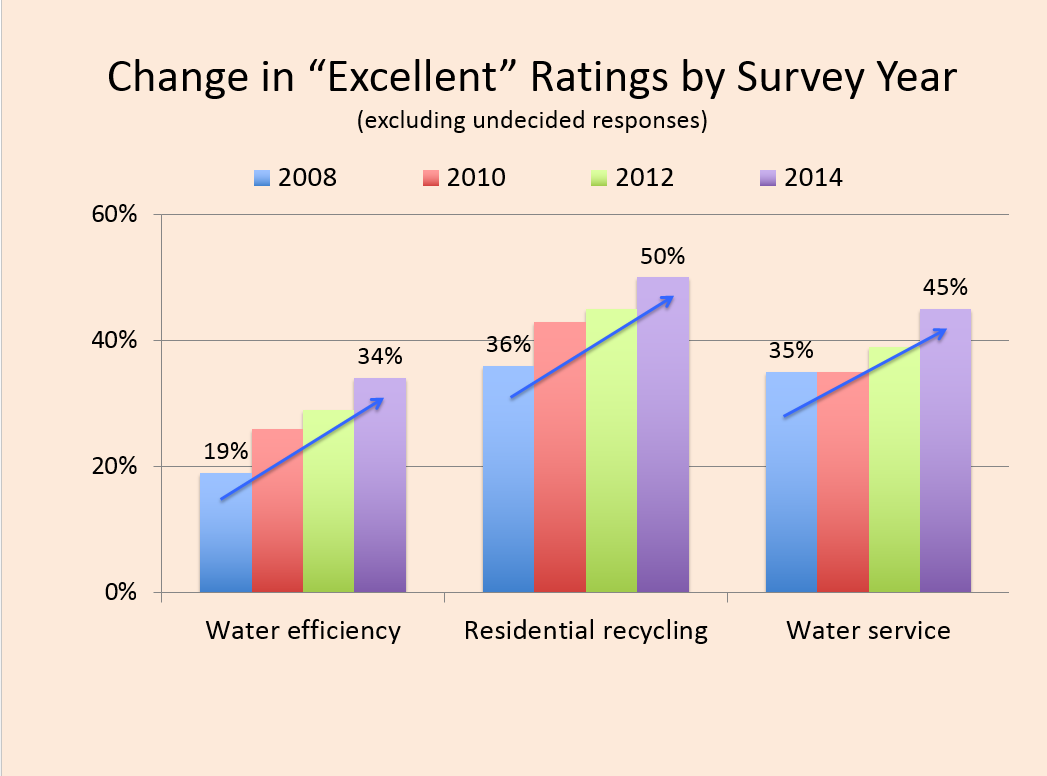Five Reasons Research Matters in Public Outreach
Turn a hunch into action
Maurice Chaney, public information officer for the City of Roseville Environmental Utilities
Many public information and outreach programs are built upon a hunch. Sometimes they’re well- informed hunches, but a hunch nevertheless. In many instances, it’s all you need to be effective.
But, imagine for a moment how much more powerful your program could be if it were trued up in research? Often, research is an afterthought or something that isn’t culturally important in many government organizations. Let’s face it: Research costs money, we are often operating in a mode of putting fires out or some managers just don’t see the significance of doing it.
A key ingredient of our communications efforts for Environmental Utilities at the City of Roseville is steeped in research. But research doesn’t have to be expensive or exhaustive. Sometimes it’s simply weighing all factors and conducting a due-diligence exercise, undertaking a literature review of case studies or executing both qualitative and quantitative research to help hit a moving target.
Research matters for a lot of reasons, but here are five that are important to me.
1: Without it, you are merely hitting a moving target
In Placer County, we have the One Big Bin system. All trash and recycling is placed in one bin and taken to a materials recovery facility where it’s sorted. Recyclables get removed and the rest is landfilled. While it sounds very convenient for the customer, it creates somewhat of a public outreach nightmare. We still need to message that customers recycle AND we don’t want everything in customers’ bin.
For years, we operated without any clear direction. We tabled at events, spent thousands of dollars on radio buys and invested in other marketing approaches like email that seemed effective but we had no real way of measuring. Everything we did was based on a hunch. Although the effort was intended to drive people to the One Big Bin website, there was no way of measuring effectiveness or ROI, and conflicting messages dampened the impact.
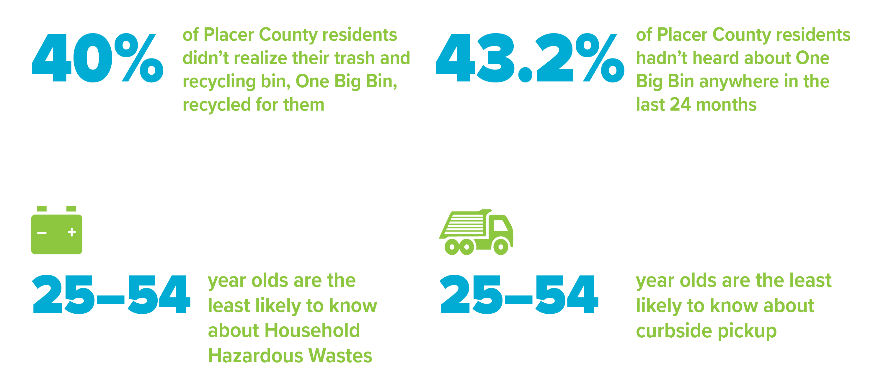 We sought out research to establish a baseline understanding of what worked, what didn’t and where we needed to invest time and energy. Results indicated that the current approaches were falling short. Base level awareness was incredibly low, especially compared to the investments made to increase awareness. We were able to re-tool our outreach program with this key insight in mind.
We sought out research to establish a baseline understanding of what worked, what didn’t and where we needed to invest time and energy. Results indicated that the current approaches were falling short. Base level awareness was incredibly low, especially compared to the investments made to increase awareness. We were able to re-tool our outreach program with this key insight in mind.
|
We retooled our outreach program based on what the research said. Unfortunately, we spent hundreds of thousands of dollars before on ineffective tactics. Thankfully, with research, we are closer to hitting that target than ever before. |
2: It aides in determining program and campaign goals
Information from research can help you develop key insights that will chart the course for developing a campaign and program goals – both of which are critically important when proving efficacy of your efforts.

For One Big Bin, we developed two key performance indicators that would guide our approach and tactical implementation of activities during the duration of the campaign.
In developing measurable goals, it improves your decision-making capabilities and reduces your risk by driving key decisions and anticipating outcomes based on those goals. In other words, everything we did had to tie back to the initial base understanding of the campaign making it an even more strategic and effective endeavor.
Our goals were specific, measurable, achievable, relevant and time-bound. In our case, our
goals were tied merely to the efficacy of the communication effort and increasing awareness 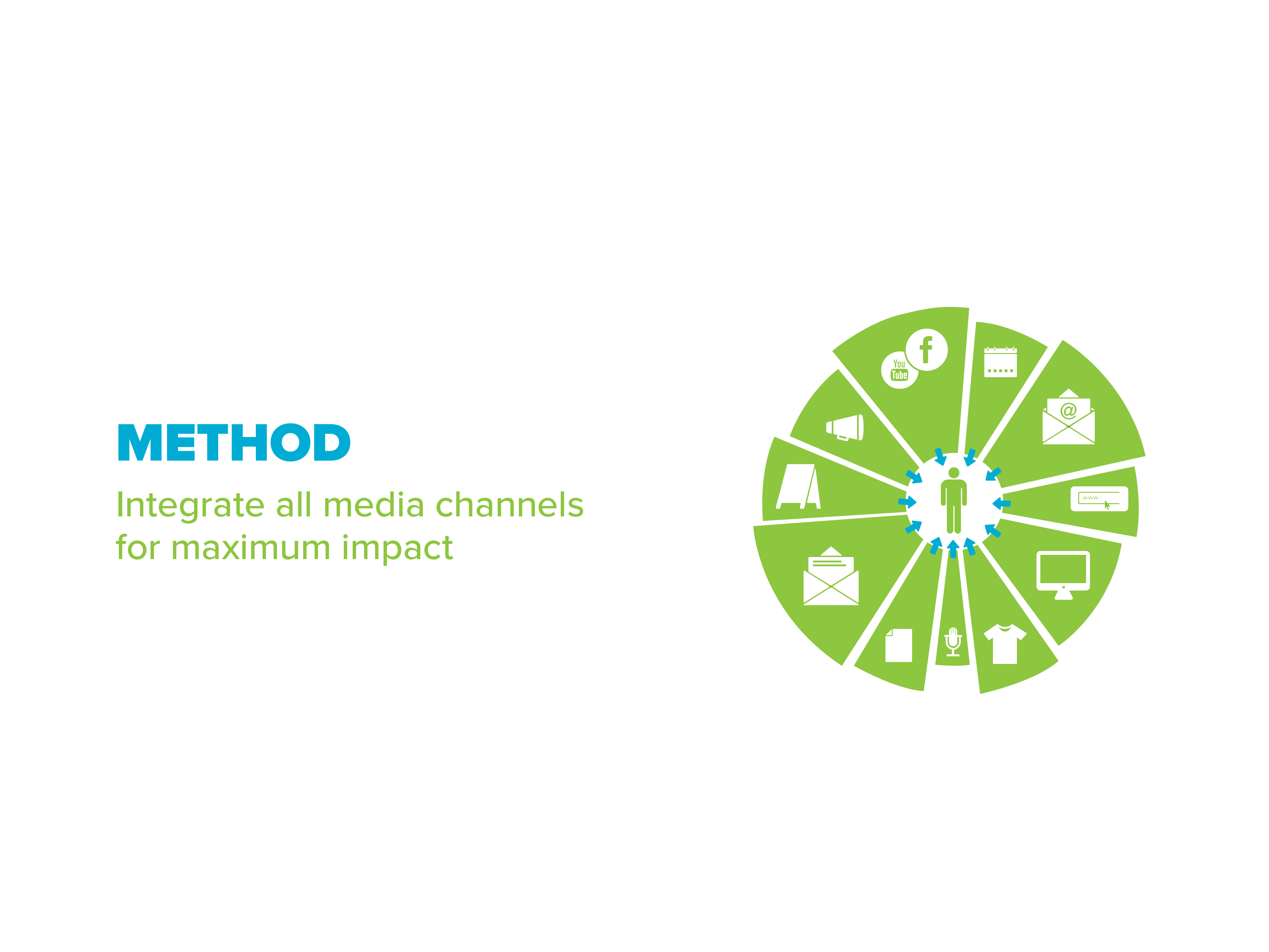 using a multi-channel approach. We used research to guide us towards this thinking as it
using a multi-channel approach. We used research to guide us towards this thinking as it
revealed a need to change our tactical approach that were rooted in the goals we
established early on.
|
Using research, we were able to develop communication goals to chart our course and it now sets us up to determine how effective we are during evaluation phase of the campaign. Developing goals requires some level of understanding of who you’re trying to reach, how and when. |
3: It uncovers customers’ real perspective
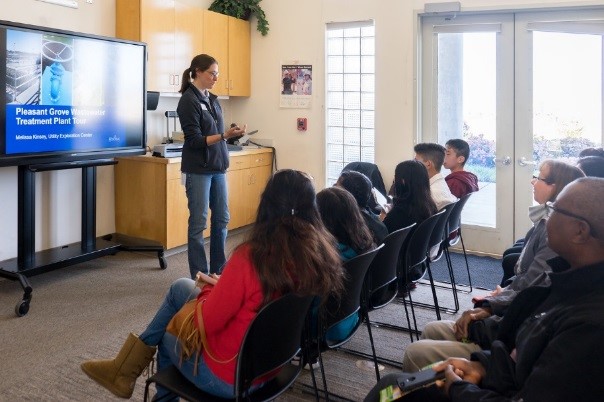 We are beginning to build a more robust outreach program around our wastewater utility. In Roseville, we receive a bulk of our water from surface water supplies. But we know that given weather pattern changes, regulatory activism and other things outside of our control, we have to investigate options to build more robust water supplies – from increased groundwater use and more ways of getting surface water to advance treatment of wastewater.
We are beginning to build a more robust outreach program around our wastewater utility. In Roseville, we receive a bulk of our water from surface water supplies. But we know that given weather pattern changes, regulatory activism and other things outside of our control, we have to investigate options to build more robust water supplies – from increased groundwater use and more ways of getting surface water to advance treatment of wastewater.
Thanks to research, we are using it currently to craft strategies with actual customer input in mind. Here is real, candid feedback when asked about wastewater:
- “The only way you can satisfactorily make somebody feel comfortable about heavily treated sewer water is through the science behind getting it clean and drinkable.”

- “Oh hell no! Absolutely not! You can’t boil that. Ew!”
- “If it’s all staying in Roseville, then I kind of like that and it gives us a better reason to contribute towards it.”
The insight we received from this research efforts has assisted us in developing a public educational tour program of our facilities with associated collateral materials that speak to what the research told us and how
| We used research to build internal trust for communicating about wastewater. But also crafted programs (award-winning facilities tour) and materials (brochures, animated videos) with information gleaned from what people said during stakeholder interviews. |
we can ultimately change thinking associated with wastewater: Communicating the scientific aspects (safety and regulations to protect public health) of wastewater and underscoring the value of purified wastewater as part of our water supply portfolio.
This year, we are implementing additional tactics and will do another cycle of research to see where we can learn more, understand what resonates and adjust strategies and tactics moving ahead.
4: Can use it to harness data and insights to drive pre-launch decisions
A great tactic to use before launching a campaign is split testing. Why spend countless dollars once your campaign has launched when you can do it beforehand to get to what resonates?
Split testing lets you test different versions of your campaign to see what works the best or to improve upon future campaigns.
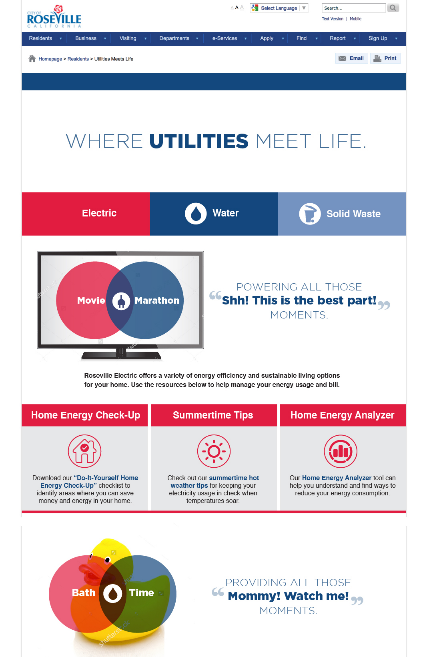

This is something that we did with a campaign several years ago called Where Utilities Meet Life. In this case, the differentiator was not in the creative look and feel but the tonality of the message. In order for split testing to be successful, you want to test one specific factor for conclusive results.
On the left is what we call the “moments” creative where we were trying to come up with moments where we intercepted with customers lives. On the right was a more fun and playful and use of idioms in a fun way. Through testing, using Facebook, the one on the left won and we led with that version throughout the duration of the campaign. Now, you can do this with Facebook as part of your advertising buy. This same approach can occur as part of focus group testing, and allows you to prioritize what your audience wants and get feedback and adjust. This can work for spec creative and key message development prior to launch.
5: Allows for measurement overtime
Every two years, we invest in research to understand how we are doing as a utility. This is critically important to understand where we fit into the minds of our customers and even determine if we move the proverbial needle.
- We look at how customers feel about us. Their satisfaction.
- What programs they use or don’t use and why.
- What programs and services they are aware of.
- What they want to learn more about.
- Where they get their information from.
Research does come at a cost, but it doesn’t have to be entirely expensive
Either way, you reap the benefits of doing a bit of research in advance of a project—even in-house survey development and deployment is one step closer than doing nothing at all, for example.
All research methodologies have their pluses and minuses, so it’s helpful to weigh all options and determine what type of feedback you want to glean to make more informed decisions. And you can absolutely cherry pick research methodologies (or use them complementary to glean richer results) depending on what your overall goal is of the campaign or program development effort you are doing.
What I will say is this: Conduct whatever research you need to make an even better decision. It’s not fail proof certainly. But it will help reaffirm that hunch or hypothesis you might have or steer you into a direction that is more strategic and deliberate.
|
We establish a baseline and measure against it to see what changes have been made, why those changes have been made and what can we do to effectuate change moving ahead. You can even tap associations that measure the same metrics to benchmark against like-minded agencies so you can see how you rank against others doing the same type of work. |
